Kayaking Quirpon Island (Copyright © 2019 David Tilley)
The Cape Bauld lighthouse on Quirpon island is the northernmost point on the island of Newfoundland. It overlooks the Labrador straits where powerful tides bring rough seas as the frigid waters of the North Atlantic mingle with the warmer gulf waters. The narrow expanse funnels the tide in a bottleneck where seas rise abruptly and without warning. The mixing of warm and cold stirs up plankton that forms the base of the food chain making these waters a rich feeding ground for fish, marine mammals and birds. The strait itself is a highway for their migration.
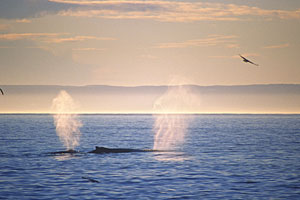
As the seas calm and the sun sets over the distant coastal mountains of southern Labrador multiple spouts of steaming whale breath appear scattered across the horizon, glowing in the yellow light. Humpbacks surface to exhale, swimming briefly along the surface before diving once again, sounding to the depths to corral schools of spawning capelin.
Throughout the summer months mammoth icebergs pass continuously nearing the end of a long journey from Greenland through the Labrador sea. Some pass to the west to flounder quickly along the landwash to Eddy's cove, consumed by a combination of warm air and water. Others are given a longer lease on life as they continue with the frigid Labrador current down the northeast coast of Newfoundland, transforming and crumbling into remnants of their former size along the way.
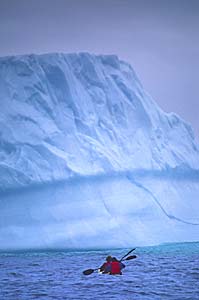 What better place for an introduction to sea kayaking. Some people don't like to fool around, as was the case with Mike and Rhonda who were down from Ontario to exchange choking city smog for clean salt air.
Both were office workers who had never been on the ocean, let alone in a kayak. Mike asked me to come along to get a few shots that would make their vacation a little more memorable. I can imagine that even without
the pictures it was a trip that they wouldn't soon forget.
What better place for an introduction to sea kayaking. Some people don't like to fool around, as was the case with Mike and Rhonda who were down from Ontario to exchange choking city smog for clean salt air.
Both were office workers who had never been on the ocean, let alone in a kayak. Mike asked me to come along to get a few shots that would make their vacation a little more memorable. I can imagine that even without
the pictures it was a trip that they wouldn't soon forget.
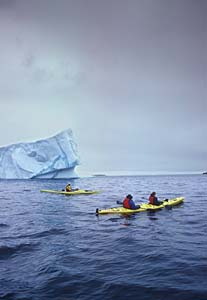 Being use to the ocean and canoeing around some of the bays I would have been checking the forecast and watching the sky continuously. Inexperience can be a blessing in some cases, especially when you have a guide like Nelson Pilgrim. A retired local school principle who's knowledge and expertise is a must in this type of environment. Nelson is one of several full time staff who conduct tours from and provide accommodations to guests from all over the planet seeking rest mixed with adventure in this far flung
destination, remote and exotic, even by Newfoundland standards. The old lighthouse keepers quarters provide a comfortable shelter in an often stark and foreboding place. It must have been a tough job for light keepers who had to stick out the long winter months here. It is easy to imagine the sheets of freezing water clinging to the treacherous cliffs in a cold winter gale and the relentless pounding of the sea roaring through the long dark night.
Being use to the ocean and canoeing around some of the bays I would have been checking the forecast and watching the sky continuously. Inexperience can be a blessing in some cases, especially when you have a guide like Nelson Pilgrim. A retired local school principle who's knowledge and expertise is a must in this type of environment. Nelson is one of several full time staff who conduct tours from and provide accommodations to guests from all over the planet seeking rest mixed with adventure in this far flung
destination, remote and exotic, even by Newfoundland standards. The old lighthouse keepers quarters provide a comfortable shelter in an often stark and foreboding place. It must have been a tough job for light keepers who had to stick out the long winter months here. It is easy to imagine the sheets of freezing water clinging to the treacherous cliffs in a cold winter gale and the relentless pounding of the sea roaring through the long dark night.
Its a rare privilege to be able to visit a place like this to enjoy the oceans marvels without having to endure the accompanying hardships of bygone days. The modern light is fully automated but the lodgings now
a bed and breakfast help to keep the lighthouse keeper tradition alive by letting people share in the adventure of the setting. The Cape Bauld Lighthouse Inn, run by Explore Newfoundland Adventures is one of the islands most popular destinations with international tourists. Islanders are equally impressed with its rugged character. This is truly a place of discovery. In all probability the first land sighted by the Vikings who later settled at Lanse aux Meadows a few km further west.
Quirpon island is long, narrow and barren, stretching for several kilometers from just off the small port of Quirpon northward. A bold platform rising high above the sea it is a fortress fortified with impenetrable walls of vertical stone. Safe harbour is difficult to find in places like these.
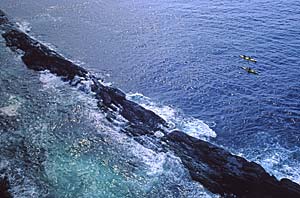 Below the lighthouse a small floating platform is anchored with steps leading up the rock in a narrow slot that cuts into the shoreline. This serves as a landing in fair weather. When the swells are high the sheltered waters of Lanse aux Pigeon offer the only safe landing for several miles of coastline. This is where we are headed today. It is a easy and pleasant hike through the rolling barren hills just over the ridge to the eastward and this historic harbour of vital importance to mariners. Morning fog lifts rapidly as the sun rises on a warm day in June. A lone cabin sits at the bottom of the harbour giving way to a low valley nestled beneath the hills.
Below the lighthouse a small floating platform is anchored with steps leading up the rock in a narrow slot that cuts into the shoreline. This serves as a landing in fair weather. When the swells are high the sheltered waters of Lanse aux Pigeon offer the only safe landing for several miles of coastline. This is where we are headed today. It is a easy and pleasant hike through the rolling barren hills just over the ridge to the eastward and this historic harbour of vital importance to mariners. Morning fog lifts rapidly as the sun rises on a warm day in June. A lone cabin sits at the bottom of the harbour giving way to a low valley nestled beneath the hills.
The cabin is owned by a famous local resident, Earl Pilgrim , a retired game warden and writer whose latest book Curse of the Red Cross Ring tells the intriguing story of murder and mass suicide at this remote fishing station.
Lanse aux Pigeon once had a population of 37 people who came from NDB to fish for cod during the summer months. The story ties the discovery of an ancient Viking burial site with the arrival of a suspected murderer
and the sequence of tragic and cursed events that unfold leading to the demise of a once prosperous community. The island itself has a longer history of supernatural events. Known in earlier times as an isle of demons, French sailors bore crucifixes when forced to land here to ward off the evil spirits that were thought to dwell in this dark and mysterious place.
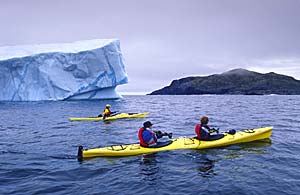 Sunlight burns away the last wisp of fog from the hill tops revealing a starkly beautiful and peaceful landscape, belying its dark and distant past. Shoals at the entrance dampen the tides so that even during a gale the "lanse", a French word for cove is relatively calm. We are fortunate to have the spectacle of a huge iceberg grounded at the mouth of the cove. Rounding the iceberg is the replica Viking ship Snorri, out from Lanse aux Meadows to cruise the bergs. The ships arrival in 1998 marked the 1000th anniversary of Leif Erickson's discovery of the new world by retracing the original route from Greenland to Vinland. The same tides that continue to bring the icebergs to these shores aided the first European explorers in discovering this basket of plenty at the edge of the known world.
Sunlight burns away the last wisp of fog from the hill tops revealing a starkly beautiful and peaceful landscape, belying its dark and distant past. Shoals at the entrance dampen the tides so that even during a gale the "lanse", a French word for cove is relatively calm. We are fortunate to have the spectacle of a huge iceberg grounded at the mouth of the cove. Rounding the iceberg is the replica Viking ship Snorri, out from Lanse aux Meadows to cruise the bergs. The ships arrival in 1998 marked the 1000th anniversary of Leif Erickson's discovery of the new world by retracing the original route from Greenland to Vinland. The same tides that continue to bring the icebergs to these shores aided the first European explorers in discovering this basket of plenty at the edge of the known world.
The new world adventurers take to the water like ducks. Heading out on a calm sea in single and double kayaks the glistening mountain of ice looms large over our heads. The tiny kayaks diminished to the appearance of wooden splinters bobbing in the swells at its base. Heads disappear and reemerge amidst the furrows of moving water. Knifing through the waves the nimble boats soon round the point where white spray shoots up the rock face. The lashing of foam on rock hints at the oceans mighty elastic power as long waves pass calmly under the hull to snap explosively when compressed by shoals.
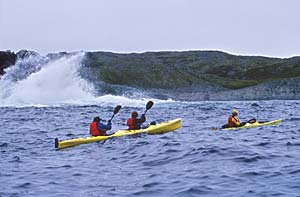 Passing in front of the lighthouse we meet a minke whale that has been circling the cove for the past couple of days. Occasionally the kamikazes of the sea, Northern Gannets fire their bodies in a volley making a vertical high speed drop moving from air to water in an instant. Using the momentum of their steep dive, they swiftly maneuver to surprise unwary prey with lightening strikes beneath the surface. Rounding Cape Bauld the coastline transforms into a sheer rock cliff stretching for several km to the southwest. The boats give the cape and lighthouse a wide berth avoiding the tumultuous collision of currents that follow opposing shores.
Passing in front of the lighthouse we meet a minke whale that has been circling the cove for the past couple of days. Occasionally the kamikazes of the sea, Northern Gannets fire their bodies in a volley making a vertical high speed drop moving from air to water in an instant. Using the momentum of their steep dive, they swiftly maneuver to surprise unwary prey with lightening strikes beneath the surface. Rounding Cape Bauld the coastline transforms into a sheer rock cliff stretching for several km to the southwest. The boats give the cape and lighthouse a wide berth avoiding the tumultuous collision of currents that follow opposing shores.
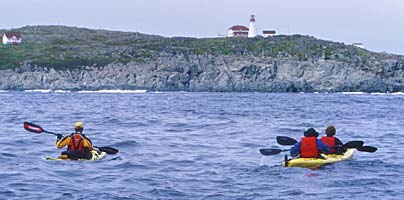 The trip is a smooth one, following the leeward cliffs with icebergs drifting and whales spouting at the west. The wind drops as the noonday sun warms the rock radiating its heat back to the water. Huge blocks of ice appear over the northern horizon. I can only guess at their actual size as they appear massive even at a great distance. Occasionally a flock of turrs flys low over the water winging around the cape heading for quieter waters. The swells and wild oceanic nature of this place are a constant distraction. The tiny kayaks are barely noticed by the birds in this vast ocean wilderness.
Returning up the shore later in the afternoon a steady NE breeze is starting to stir up the waves. Landing in the cove next to the lighthouse is a bit trickier than the morning launch but everything goes well and the reborn kayakers are on a natural high from the combination of air exertion and excitement. Commenting on the sudden change, Nelson cautions "this is the roughest place in the world". There's no time to argue, as the waves keep getting bigger, its no longer possible to land a larger boat near the lighthouse.
The trip is a smooth one, following the leeward cliffs with icebergs drifting and whales spouting at the west. The wind drops as the noonday sun warms the rock radiating its heat back to the water. Huge blocks of ice appear over the northern horizon. I can only guess at their actual size as they appear massive even at a great distance. Occasionally a flock of turrs flys low over the water winging around the cape heading for quieter waters. The swells and wild oceanic nature of this place are a constant distraction. The tiny kayaks are barely noticed by the birds in this vast ocean wilderness.
Returning up the shore later in the afternoon a steady NE breeze is starting to stir up the waves. Landing in the cove next to the lighthouse is a bit trickier than the morning launch but everything goes well and the reborn kayakers are on a natural high from the combination of air exertion and excitement. Commenting on the sudden change, Nelson cautions "this is the roughest place in the world". There's no time to argue, as the waves keep getting bigger, its no longer possible to land a larger boat near the lighthouse.
Anxious to make a few more stops on the Northern peninsula, I say goodbye for now and jumping aboard a speedboat to head around the point for Lanse aux Pigeon where a larger boat waits to head back to Quirpon. Its a short wet trip hunkered down in the little boat with spray coming from all sides. Entering the cove I can see steep walls of water rising against the shoals opposite. The surface at the dock is surprisingly calm however and soon we've switched boats for the trip back. As a thick fog closes in the looming cliffs disappear occasionally.
Quirpon Island
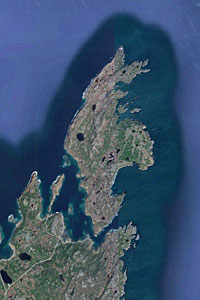
The sun appears to be fighting a battle to stay in the sky, so I grab my camera from a storage locker to get a shot. This is no place for photography however with the constant rolling and drenching spray. Waves to windward have taken on mountainous proportions and I'm glad I'm with a couple of locals. Both of whom appear oblivious, just enjoying a routine trip back home.
This is no routine for yours truly, a far cry from paddling in many of the islands sheltered bays. An eventful day but just the beginning of a week of continuous exploration and discovery. The wildlife and landscapes make the entire area an experience not to be missed. It is still one of the most unspoiled and diverse parts of the province and a virtual paradise in summer. Leif Erickson and his crew could have continued south to milder climates but the hardy northerners chose to stay, I can't say I blame them.
